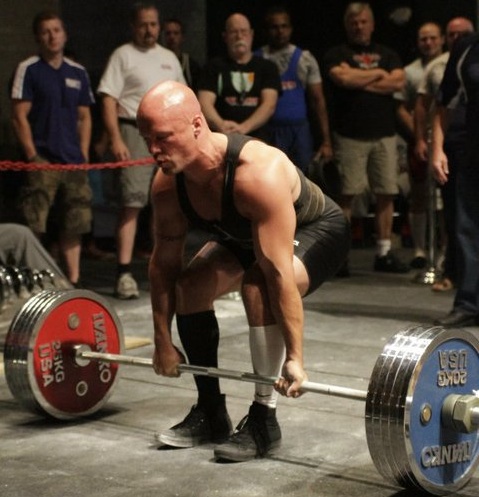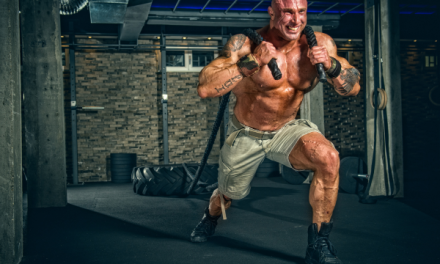A lot of people just don’t understand the function of these muscles, but also, they don’t understand how to train them properly.
So, I’m going to just unload a couple different things that you need to know on how to train them properly in order to either get the gains that you want or see the performance or even the restorative health that you’re looking for.
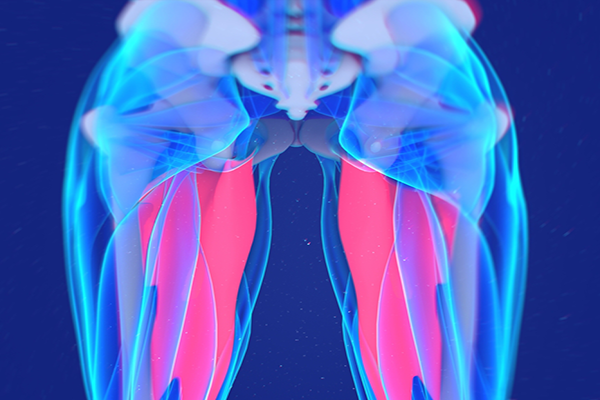
Meet the Adductors
In short, the adductors are your inner thighs, like I said, but they’re responsible for two functions. One is adduction; two is internal rotation of femur.
I’m telling you this because this is important. Adduction obviously it just bringing the leg back to center of the body.
A lot of people abuse the word adduction in abduction. Abduction is A-B-duction, adduction, you’re adding your limb back to the body.
When people hear adduction it could be an arm and a leg. Right now, we’re talking about inner thigh.
So, adduction is when you swing your leg back in, you know, a thing like that, or even kicking a soccer ball. You’re adding a leg back to the body.
Internal rotation of the femur. Your femur is your thigh bone. So, when you take a step and pivot so now my leg has to come this way, that’s internally rotating your femur. Or if you have to step over something, that’s internally rotating.
A lot of people, they don’t train this muscle properly because they don’t know the functions of this.
So, when you take that into consideration, doing the seated adduction machine, the adductor machine, the one that is commonly used at the gym by mostly women, that’s a good machine, but that doesn’t hit both plains of motion.
Yeah, you’re adding the leg back together, you’re doing a little internal rotation, but you’re so isolated in that movement.
How you train the adductor is done through one of two ways. So, there’s two methods, okay? Let’s get this straight. So, you have unilateral and wide stance.
So, these are the two methods that you have to use when training your adductors. You have to do unilateral training specific to the functions of the muscle. But also, you need to have a wider stand to hit the adductors.
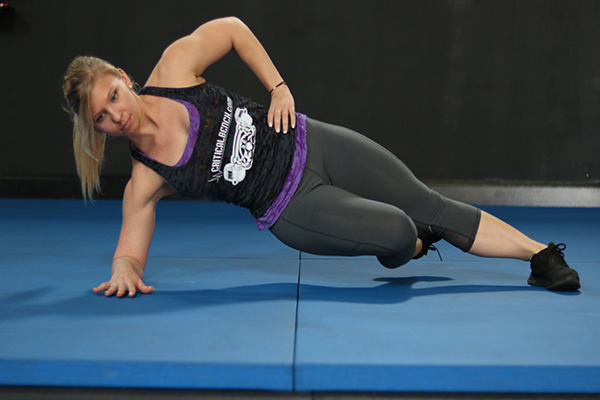
Go Wide in the Stance
Now don’t confuse a wider stance with thinking more of the outside of the quads where people say hey, I’m going to move my feet a little wider so I’m going to get more on the outside of my vastus lateralis, your thighs. You’re hitting more of your adductors.
Again, like I just said, to summarize the wider stance, this is more like your sumo stance.
It could be a sumo stance with your squat, your deadlift, body weight squat, squat jumps, box jumps, broad jumps, anything that has a wider base to it.
I’m going to show you the significance of that and how to get into that position properly in just a moment.
As you can see there’s really four things you need to know before we move on.
Adduction bringing the limb back to the body, internally rotating the femur.
So, you’ve got to train through those two ranges of motion, or those two functions within these two exercise methods.
Unilateral training, that just means one limb at one time, so right leg versus left leg. And also training a wider stance.
You’re also probably thinking how can I do a wider stance with the unilateral movement?
Well, you really can’t unless you’re doing a walking lunge, which I’ll show you in just a second. So, this is going to be more of your compound movements.
This is going to be like, like I said, Sumos. That’s pretty much the only way you can do a wider stance, is when you go out wide.
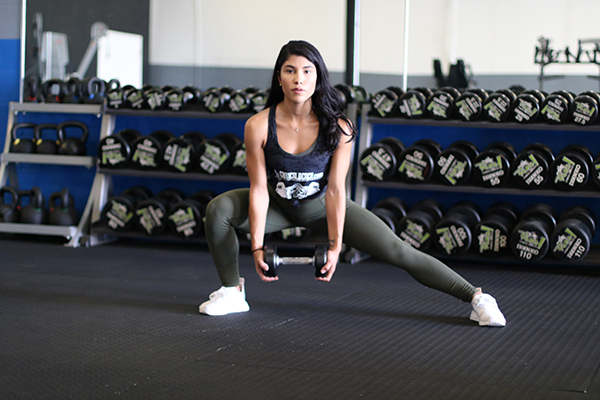
Enter the Sumo Stance
So, think of a back squat. You’ve got the bar on your back; your traditional stance is here. Down, up.
Wider stance is traditionally called a sumo stance. So, your feet are pointed out maybe 30 to 45 degrees, still the same thing applies.
Now, this is when we’re going to start getting into more of the function of the adductors and also the responsibility that they have to making sure that your posture is good.
So, when you squat down in a wide stance, one of two things will happen.
Either you’ll successfully lift it or you’re going to fail. And I’m not talking you’re going to fall, but failing would be something like this where your knees cave in.
This is really one of three things that could be taking place. Weak glutes, because abduction is all upper glutes.
If you have weak upper glutes you don’t have the strength to keep your knees open. If you have weak adductors, weak inner thighs, the same thing is going to happen as you come down you’re not going to be able to have the strength to keep them open.
Now also, if you have extreme tightness on your inner thighs, that’s going to cause the valgus effect, you’re going to roll in. And you see a lot of people doing this. They fall like this. So, you can see the importance of training your adductors is to keep your body in a stable position.
If you want to get a stronger deadlift, you have to train your adductors.
Now, if you’re not going to do things like certain types of lunges to get your adductors as strong as you can. So just hopping on that adductor machine, that inner thigh machine won’t actually get you stronger.
It might help sculpt a little bit, bit you’re forgetting the principles of it, is bringing the leg back to the body through unilateral training and you’re actually in a wide stance with some internal rotation of the femur.
I know this is getting a little confusing for you, but hopefully it’s not. So, let me just clarify it in another way.
When you’re just going through any type of movement, wider stance is the best for the adductors.
You’re not going to hit less quads. It’s, if anything, going to take away—you’re still going to hit the quads, but you’re just going to focus more of activation muscle recruitment on the inner thighs.

Importance of the Adductors
Again, when you go down, you’ve got to keep your knees open and then stand back up. So, take a look at these exercises, these sumo types of exercises that you can use that are going to hit the adductors.
So, as you can see there are a bunch of different types of variations that you can do to hit the adductors.
Now, again, why are we spending so much time on the adductors?
A lot of people think, oh, they’re just another part of the body.
Well, they are, but a lot of people just think quads and hamstrings. So that’s even more emphasis should be placed on the adductors because not enough time and effort is spent on those muscles.
They’re also—with the adductors they help with hip flexion, hip extension; they help brace your core. So, you don’t want them to be weak.
Your adductors are larger than your hamstrings. Got that? I’ll say that again.
Your adductors are larger than your hamstrings.
It is the way it is.
Quads are number one; adductors are number two; hamstrings are number three.
So, if you take that into consideration, you want to train your adductors more than your hamstrings.
That just should be the way it goes. These muscles in here, there’s actually five muscles in there, it’s not just one adductor magnus.
The entire adductor group is much larger than your hamstring.
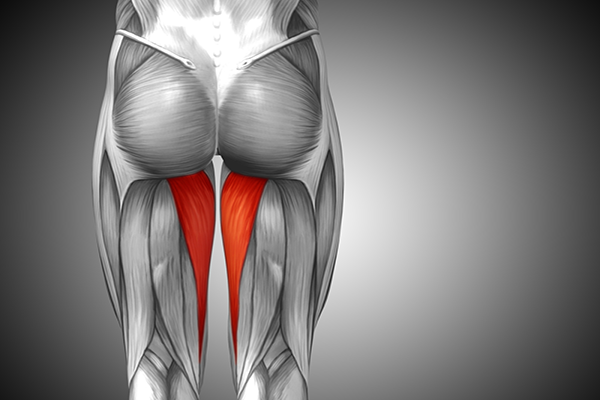
The Adductor Workout
So, let’s talk about training your adductors and what that actually looks like in your program.
When you’re training your adductors take everything I just gave you into consideration when you’re doing your training.
Some people say, hey, I’ve got a lower body day. I’ve got a quad day. I’ve got a glutes day. I’ve got an arm day.
Why not do an adductor day or more adductors on your lower body day?
So, like I just said, quads are most dominant, adductors are second, hamstrings are third.
So, if you want to train with that in mind, maybe three exercises of your quads, three exercises of your adductors, could be three exercises of your hamstrings. So, you’re giving them all the attention that they deserve.
Now, if you feel like you’re quad dominant, maybe spend a little more time on your adductors and your hamstrings. Just the opposite of that if you have bigger hamstrings and you want to focus on your quads.
Spend a little more time on your adductors. Don’t forget the adductors. I can’t stress that enough.
Just the same thing with glutes. A lot of people fail to do glute training properly. So, what I personally recommend as a strength coach is to train your glutes and your adductors at the same time in the same workout and you can do these in many different ways. You can do a glute specific day, adductor specific day.
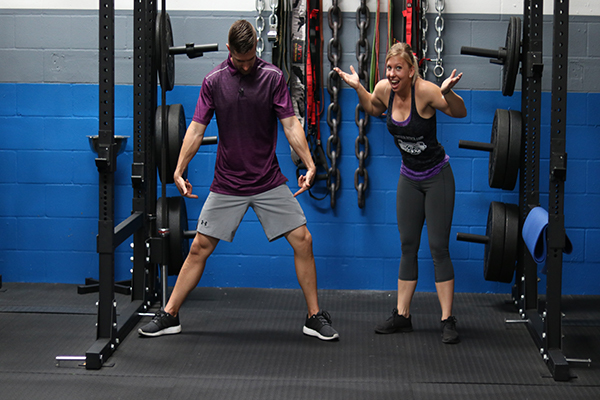
Focus on the Adductors for a Better Butt
Now, let’s talk about vanity for a second.
A lot of people, a lot of women want a nice, better shapelier butt. But sometimes they forget to do adductor work. You know, that’s that inner thigh area.
If you have good glutes, but you don’t have a good inner thigh area, it’s an incomplete look.
Quads are good, hamstrings are good, butt is good, but the adductors are lacking. It’s because they’re not training properly, not doing the exercises that are needed.
Acute Variables for an Adductor Workout
So, when you’re doing a program, same protocol as any type of other muscle group.
Multiple sets, two to four sets. If you’re going for strength, you want stronger adductors to help you on a stronger deadlift or squat, lower repetitions, higher resistance and longer rest periods. So that could be anywhere from three to eight repetitions, 60 seconds to two minutes of rest and also maybe three or four sets.
If you’re looking to add some muscle in that particular area of the body, eight to 12 repetitions anywhere from 60 to 90 seconds of rest, three to four sets. Now if you want more of definition, more of like a cardio effect, like a burning sensation in your inner thigh, higher reps, 15 to 20, 25 to get that burning effect, less rest, 15 to 30 seconds between each exercise or set and moving on to a bunch of different exercises.
Again, those are the exercises you saw earlier, you can select those and build a whole adductor routine just based on those exercises. Hopefully I didn’t leave anything out. I’m pretty sure I completed the one-on-one on adductors.
Adductor Exercises for the Win
Just, again, I’m going to summarize it in a couple seconds.
Two functions: adduction, internal rotation of your femur. You need to train with unilateral mind set and also a wide stance.
You also need to place a little more importance on training your adductors to get a more fullness effect of the leg.
Now, again, don’t confuse what I’m saying if everything is you’re going to bulk up and you’re going to add inches to your adductors. That’s how not strength training goes.
Again, if you’re looking to get stronger adductors, you’re not going to put on size. If you train for size, yeah, you probably will be putting on some size.
Take everything I just gave you and kind of figure out what’s going to work best for you and hopefully you’ll apply some of these principles into your training.
If you have any questions on this topic, on adductors/inner thighs, use the comment section below.
I’d love to hear what you have to say. If you have a comment, a question.
I will check back regularly to get information sent to you somehow, some way to help you with your training.
But something else that’s going to help you with your training is a report that I wrote.
It’s call the 5-Minute Glute Workout.
It’s going to parallel this. It’s going to help you understand the importance of glute training and also muscle activation and the things that you need to do to wake up the glutes, but also the secondary muscles like the adductors.
by Brian Klepacki, MS, CSCS, FMS2
CLICK HERE to Instantly Download a FREE Copy of
The 5-Minute Glute Workout
For More Great Pics & Vids, please visit our CriticalBench Fan Page, http://www.facebook.com/criticalbench
For the BEST YouTube Videos on the Planet, please visit our main CriticalBench Channel, http://www.youtube.com/criticalbench
and our Critical Bench COMPOUND Channel, http://www.youtube.com/gymexercises
And if you haven’t yet, please start following us on Instagram @thecriticalbench


